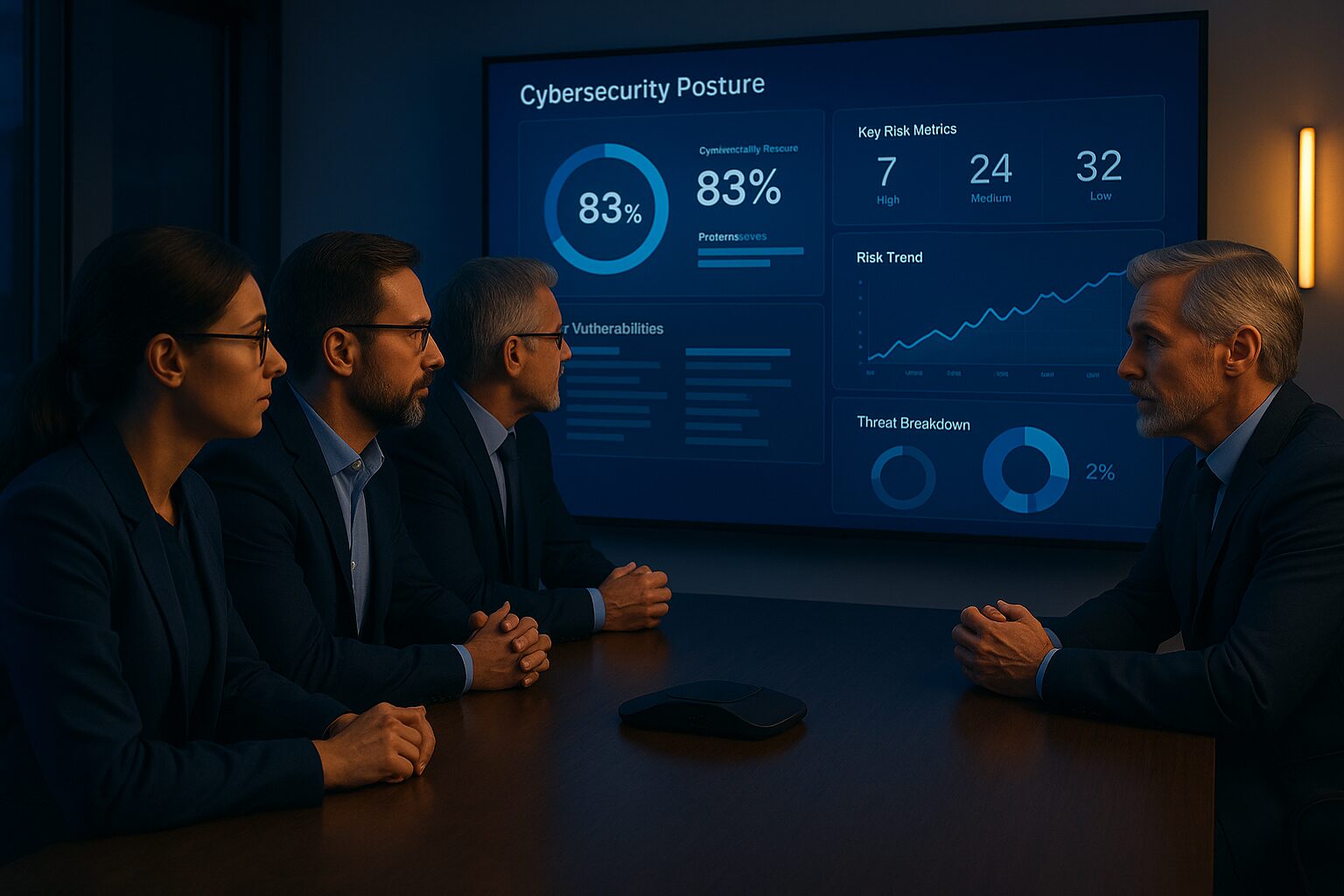If you manage a specialty practice or a senior living community, HIPAA compliance probably isn’t the reason you got into healthcare. But in 2025, it’s a reality you can’t afford to ignore.
Cyber threats are rising across the board. Healthcare data breaches have hit record highs for the third year in a row, and the Office for Civil Rights (OCR) is responding with more audits, steeper penalties, and fewer second chances. At the same time, your tech environment has never been more complex—between remote staff, cloud systems, and EHR integrations that barely talk to each other.
And yet, a lot of compliance advice still reads like a legal manual.
This HIPAA compliance checklist is different. It’s built for real-world healthcare delivery, where IT teams are small, risk is high, and administrators are already stretched thin. Whether you’re in urology, GI, dermatology, orthopedics, or long-term care, this guide helps you understand where your risk lives—and how to address it through smarter systems, stronger processes, and the right IT support.
What’s Changing in HIPAA Compliance in 2025?
If you’ve been relying on the same compliance playbook from a few years ago, now’s the time to revisit it. HIPAA is shifting, and in 2025, the bar is higher—especially for smaller practices and senior care organizations.
The Department of Health and Human Services (HHS) and Office for Civil Rights (OCR) are finalizing updates aimed at improving patient access to records, tightening breach notification timelines, and encouraging more transparency around data sharing. One of the biggest changes? The expected reduction in response time for right-of-access requests—from 30 days to just 15.
There’s also new language pushing for better interoperability, which means your systems need to be able to talk to each other—and share data securely when patients ask for it. That’s no small feat when you’re juggling outdated EHRs, third-party billing tools, and cloud platforms that weren’t built to integrate.
The enforcement side is getting sharper, too. OCR has made it clear that small providers and long-term care facilities are not exempt from fines. In fact, those with weaker documentation and fewer technical safeguards are often under the most scrutiny.
For a deeper breakdown of these changes, we cover the proposed rule in detail here:
👉 Proposed HIPAA 2025 Security Rule Update: What It Means for Healthcare Practices
And even if you’re not technically a covered entity under HIPAA, you’re not off the hook. The FTC Safeguards Rule and CISA (Cybersecurity and Infrastructure Security Agency) guidelines are extending their influence into adjacent sectors—especially when financial or health-adjacent data is involved.
In short: Compliance isn’t just about policies anymore. It’s about proof. The burden of documentation, risk assessment, and technical controls is now squarely on your shoulders, no matter the size of your organization.
This checklist will help you prepare for what’s ahead—so you’re not playing catch-up when the audit letter lands.
Simplify Compliance with the Right IT Partner
Why Specialty Practices and Senior Living Are High-Risk Targets
If you’re running a urology clinic, a memory care center, or a dermatology practice, you might assume hackers are more interested in big hospitals. But the data says otherwise.
According to 2024–2025 HHS breach reports, small and midsize healthcare organizations made up over 60% of reported cyber incidents. That includes private practices, outpatient clinics, and long-term care facilities. The reason is simple: attackers are going after the softest targets.
Specialty and senior care settings often rely on shared workstations, aging hardware, and a patchwork of cloud tools that don’t play nicely together. IT teams, if they exist, are stretched thin. Legacy EHRs still linger. And when updates or MFA rollouts are delayed “until next quarter,” it creates openings.
Ransomware groups know this. They’re targeting these environments because the stakes are high—canceling appointments or relocating residents isn’t just inconvenient, it’s dangerous. That urgency often leads to fast payouts and quiet settlements. It also means a higher risk of regulatory penalties if incident response plans aren’t solid.
And let’s not forget the technical gaps:
- Shared devices where multiple staff log in under a single account.
- Cloud storage misconfigurations exposing sensitive data online.
- Unpatched endpoints that haven’t seen a security update in months.
These aren’t hypotheticals. They’re real vulnerabilities found every day in practices and facilities that simply don’t have time to think about cybersecurity—until it’s too late.
That’s why HIPAA compliance in 2025 has to start with understanding your risk surface. Because even if you’re small, the impact of a breach can be massive.
The 2025 HIPAA Compliance & IT Risk Checklist
Compliance isn’t just about having policies—it’s about whether your systems, people, and partners actually reduce risk. This checklist isn’t a legal manual. It’s a practical, IT-informed guide built for real-world healthcare environments. If you’re juggling limited tech resources and rising security expectations, this is where to focus.
Administrative Safeguards (Through an IT Lens)
This is where HIPAA and IT strategy really meet. It’s not enough to have a binder of policies. In 2025, you need administrative safeguards that actually reflect how your systems work—and how your risks show up.
Start with a documented HIPAA Security Risk Assessment that doesn’t just check boxes, but actively evaluates your infrastructure, vulnerabilities, and vendor risk. (If you haven’t done one in the last year, Meriplex can help.)
Make sure you have:
- A current, IT-led HIPAA risk assessment that includes cloud environments, EHR integrations, and remote access points.
- A written incident response plan that goes beyond “call IT.” It should include ransomware scenarios, cloud outages, and communication protocols.
- Business Associate Agreements (BAAs) on file for every vendor that touches PHI—including your Managed Service Provider, cloud storage provider, and EHR platform. Review them annually, not just at onboarding.
These administrative steps are the foundation for technical safeguards that work. Without them, even the best firewall won’t keep you compliant.
Physical Safeguards That Still Matter
It’s easy to overlook physical safeguards in a world obsessed with cloud and AI—but they’re still one of the most common HIPAA blind spots, especially in busy, shared environments.
In 2025, auditors are paying closer attention to who can physically access what, and whether your systems are protected against casual exposure as much as malicious intent.
Here’s where to start:
- Secure networking gear and EHR terminals. Make sure switches, servers, and access points aren’t sitting unlocked in a back office that doubles as storage. EHR workstations in hallways or exam rooms should log out automatically and use screen filters when possible.
- Manage shared endpoints. In senior living or outpatient settings, shared tablets or workstations are often the norm—but that doesn’t excuse unsecured access. Use centralized endpoint management to monitor usage, apply patches, and ensure proper session logouts.
- Tie access control to identity governance. If you’re using badge entry or key fobs, make sure they expire when employees leave. Bonus points if they integrate with your user management system so access is granted and revoked automatically.
Physical safeguards might feel old-school, but they’re still one of the fastest ways to reduce risk—and one of the first things regulators look for when they show up
Technical Safeguards (Meriplex POV)
Most breaches aren’t the result of some genius hacker brute-forcing your firewall. They happen because of a missed update, a weak password, or an employee who clicked the wrong link. That’s why technical safeguards matter—not just as checkboxes, but as real defenses built into your day-to-day systems.
Here’s what that should look like from a 2025 compliance and security standpoint:
- MFA should be everywhere. If a system touches PHI—even indirectly—it needs multi-factor authentication. That includes your EHR, email, cloud storage, VPN, and even your remote access tools. No exceptions.
- Protect every endpoint, not just servers. Every laptop, workstation, or tablet should have next-gen protection like EDR (Endpoint Detection and Response) or XDR (Extended Detection and Response). Antivirus alone doesn’t cut it anymore. These tools actively monitor for suspicious behavior and isolate threats before they spread.
- Backups need to be encrypted and recoverable. It’s not just about backing up your data—it’s about how fast you can get it back. You need defined RTOs and RPOs (Recovery Time and Point Objectives), and backups should be encrypted, tested regularly, and stored offsite or in the cloud with proper access controls.
- Audit logs aren’t optional. Every system with PHI access should generate logs: who logged in, what they accessed, what was changed. Those logs need to be stored securely (not in an Excel file on someone’s desktop) and reviewed quarterly at minimum. It’s one of the first things OCR will ask for if there’s a breach.
If your current IT setup doesn’t support these, or if you’re not sure how to implement them, that’s where a partner like Meriplex comes in. We help healthcare organizations and senior living communities build real safeguards—not just policies that live in a binder.
Get a HIPAA-Ready IT Risk Assessment
Role-Based Access: Most Overlooked Compliance Risk
Most practices think they’re “secure enough” because they’ve got antivirus installed and passwords in place. But one of the biggest compliance gaps we still see? Too many people have access to too much data.
In 2025, over-permissioned users are one of the top root causes of HIPAA violations—and they’re almost always preventable.
Think about it:
- Does your front desk staff need access to clinical notes?
- Should a billing contractor be able to see full patient charts?
- Is everyone using a shared login just to “make it easier”?
These aren’t just workflow issues. They’re audit risks.
A compliant IT environment uses role-based access control (RBAC) to make sure each person can only access the systems and information they need to do their job—nothing more.
For specialty practices and long-term care communities, that means segmenting access by function:
- Providers access EHR data and clinical tools
- Billing has visibility into financial systems, not diagnoses
- Admin staff can schedule appointments but don’t see treatment plans
This isn’t just best practice—it’s required under the HIPAA Security Rule.
Modern systems (especially cloud-based EHRs, scheduling platforms, and secure messaging apps) now offer granular access controls. The problem is, most teams don’t configure them properly—or at all.
Make sure your MSP or IT partner is helping you define roles, apply permissions, and regularly review who has access to what. Because when a breach happens, “we meant to lock that down” won’t be a valid defense.
Staff Awareness and Training Still Drive Compliance
You can have the best firewalls and encrypted backups in the world—but all it takes is one click on a phishing email to put patient data at risk.
HIPAA compliance is half systems, half human behavior. And in 2025, with ransomware attacks getting smarter and phishing lures more realistic, your staff is either your strongest defense—or your weakest link.
Training isn’t a one-and-done video or a checkbox on an onboarding form. It needs to be:
- Ongoing: Role-specific refreshers every year
- Interactive: Include simulations and real scenarios
- Timely: Built into onboarding and reinforced at offboarding
If you run a high-turnover environment like senior living or urgent care, the risks multiply. Temporary staff, rotating shift workers, and floaters often get skipped in training cycles—but they’re still handling PHI and logging into shared systems.
Smart organizations are running:
- Phishing simulations to teach pattern recognition and reinforce caution
- Breach response drills so staff know what to do when something goes wrong
- Access audits during offboarding to shut down logins, deactivate email accounts, and revoke badge access the moment someone leaves
You don’t need to scare your staff. You just need to empower them. Clear expectations and practical training go further than policies buried in a handbook. And when everyone knows their role in protecting patient data, the whole organization becomes safer.
Cloud Platforms and HIPAA: A 2025 Update
Cloud tools are everywhere now—EHRs, scheduling, billing, even secure messaging. But in 2025, relying on the cloud doesn’t automatically mean you’re HIPAA-compliant.
Here’s the catch: not every cloud vendor is built for healthcare, and even the ones that are don’t cover everything.
Start with this: HIPAA compliance in the cloud is a shared responsibility.
Your Managed Service Provider (MSP) or IT partner might handle encryption, backups, and server patching—but you’re still on the hook for how the data is accessed, who has permissions, and what happens if something goes wrong.
When vetting cloud platforms, look beyond convenience:
- Do they encrypt data at rest and in transit?
- Is there documented redundancy—can you recover your data if a region goes down?
- How quickly do they alert you after a breach or outage?
- Do they sign a Business Associate Agreement (BAA)?
Also, check what your MSP is actually managing. Are they monitoring your cloud environment for abnormal behavior? Are your backups isolated from ransomware threats? Or are you assuming coverage that isn’t there?
Cloud platforms can absolutely support HIPAA compliance—but only if you treat them as part of your broader risk strategy, not just a plug-and-play solution. When in doubt, ask your vendor (or MSP) to walk you through how your PHI is protected. If they can’t explain it clearly, it’s time to rethink the partnership.
Compliance Documentation & What Auditors Expect Now
In 2025, HIPAA audits aren’t about intentions — they’re about receipts.
The Office for Civil Rights (OCR) is stepping up enforcement, and small providers are no longer flying under the radar. Whether you’re in dermatology, senior living, or orthopedics, if you’re handling protected health information (PHI), you need to be audit-ready at all times.
Here’s what OCR expects to see now — and they want it organized, not buried in someone’s inbox:
- A current HIPAA risk assessment, ideally updated within the past 12 months
- Security incident logs that show how issues were tracked and resolved
- User access reviews that confirm only the right people have access to PHI
- A full Business Associate Agreement (BAA) register with signed copies
- Staff training attestations for HIPAA, cybersecurity, and privacy protocols
These aren’t just boxes to check. They’re the evidence that your organization takes compliance seriously.
The good news? You don’t have to manage it all manually.
Tools like compliance dashboards, secure document vaults, and automated audit logs (especially when bundled with MSP support) make tracking and reporting simpler. Some MSPs even offer compliance-as-a-service—taking care of the logging, reminders, and reporting, so you’re not scrambling when an audit notice lands in your inbox.
If you’re still managing HIPAA docs in a shared Google Drive, it might be time for an upgrade. Auditors don’t give points for good intentions—just good documentation.
How Managed IT Services Can Simplify HIPAA Readiness
HIPAA compliance is complicated—but it doesn’t have to be chaotic.
Most specialty practices and senior living facilities don’t have a full-time compliance officer sitting next to an in-house cybersecurity expert. That’s where Managed IT Services can take the pressure off. A good partner won’t just manage your firewalls—they’ll help you build an environment where compliance isn’t a scramble, it’s baked into the system.
At Meriplex, we work with healthcare providers every day to close gaps and simplify what’s often a tangled mess of tools, policies, and risk. Here’s how we support HIPAA-readiness across the board:
- Risk Assessments: Annual HIPAA-aligned IT risk assessments with prioritized remediation plans
- HIPAA-Ready Infrastructure: From endpoint protection to encrypted cloud backups, everything is built to meet today’s compliance demands
- Network & Endpoint Security: Advanced EDR/XDR, MFA, vulnerability scanning, and centralized audit logs—configured with compliance in mind
- Co-Managed IT Support: For practices with internal staff, we supplement rather than replace—freeing up your team to focus on clinical care
Mini Case Study:
One senior living client in Texas was managing five locations with outdated systems, shared logins, and no centralized way to track access or training. We stepped in with a co-managed support model:
- Replaced aging workstations with secure, HIPAA-compliant configurations
- Enabled MFA and endpoint detection across every site
- Provided quarterly access reviews and security awareness training
- Delivered a fully documented HIPAA risk assessment before their next audit
The result? They passed their audit with zero findings and now spend 30% less time chasing documentation.
Compliance doesn’t have to be a burden. With the right IT partner, it becomes a system—stable, secure, and always ready.
Talk to a Compliance-Aware IT Expert
Final Thoughts: HIPAA Isn’t Just About Avoiding Fines—It’s About Protecting Trust
HIPAA compliance isn’t just a checklist to keep auditors happy. It’s a reflection of how seriously you take the trust people place in you.
Whether you run a specialty practice or oversee a senior living community, you’re handling more than just medical records. You’re safeguarding someone’s personal history, identity, and care story. When that information is exposed, it’s not just a technical failure—it’s a human one.
Done right, HIPAA isn’t just a regulatory hurdle. It’s an opportunity. It pushes you to invest in better systems, smarter workflows, and stronger security that protects both your patients and your business. It gives you structure in a chaotic environment—and a way to prove, both internally and externally, that trust is something you take seriously.
In 2025, compliance isn’t about doing the bare minimum. It’s about building something resilient. And that starts with understanding your risks, aligning your technology, and choosing partners who see the bigger picture.



